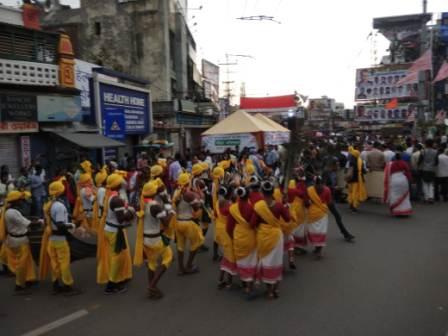BHUBANESWAR: Celebrated by the Oraon, Munda and Ho tribes across the state of Jharkhand and Sundargarh district in Odisha, Sarhul festival is one of the most popular celebrations in the region. While the festival is underway in Jharkhand, tribes will congregate in the city of Rourkela to celebrate it soon.
The festival marks the advent of the New Year for these tribes. Celebrated every year in the first month of the Hindu calendar, on the third day of the moon or the fortnight of ‘Chaitra’, Sarhul marks the advent of the spring season or ‘Phaagun’ and is celebrated till the month of June or ‘Jeth’.
This year, the festival will be organised by the combined efforts of Kendriya Sarna Samiti and Saa Parichaya Foundation. Sarhul means worship of trees. Being close to nature, these tribes start the Sarhul festival with the worship of trees and other elements of nature. It’s believed that new crops can be used only after the festival. The main attraction of the festival which is celebrated for several days is the Sarhul dance.
The fest not only spreads the message of solidarity within the tribal communities across India but also promotes their indigenous art in a powerful way. Despite being an Adivasi festival, Sarhul is not restricted to any particular part of Indian society. Other faiths and communities like Hindus, Muslims and Christians also participate in congratulating the dancing crowd.
The fest also features distinctive Sarhul cuisine. ‘Handia’ or ‘Diang’ is a special offering to the people on the occasion. It is made up of rice, water and tree leaves. Another sarhul cuisine that tickles the gastronomes of participants is termed ‘Pahan’.
Non-vegetarian offerings include fish sukha, an exclusive preparation of dried or baked fish. Apart from these specialties, leafy vegetables, roots and shoots, pulses, rice, seeds, fruits, flowers, leaves and mushrooms are also served to members of the community. A variety of mushrooms are available during this time like bhardo, bihidien and rugda.
The history of the Sarhul festival dates back to the period of Mahabharata as per several legends of Sarhul festival. The history of the Sarhul festival reveals that this festival is celebrated in the spring season. It is when the villagers offer prayers to the village God, who is the protector of the tribe. During the festival, Sal flowers are brought to the sarna (sacred grove) and the pahaan (adivasi priest) propitiates all the gods of the tribes. A sarna is a cluster of trees where the adivasis would worship in various occasions.
Such a grove among many others must house at least five sal trees also known as sorjum, held very sacred by the tribals. It is a worship of the village deity who is considered to be the protector of the tribes. People sing and dance a lot when the new flowers appear. The deities are worshiped with saal flowers.
Tribes all across Odisha and Jharkhand celebrate this festival with great fervour and joy. It is believed that after this festival the earth becomes fertile and the process of sowing is started. It also depicts the diversity in culture of our nation.
